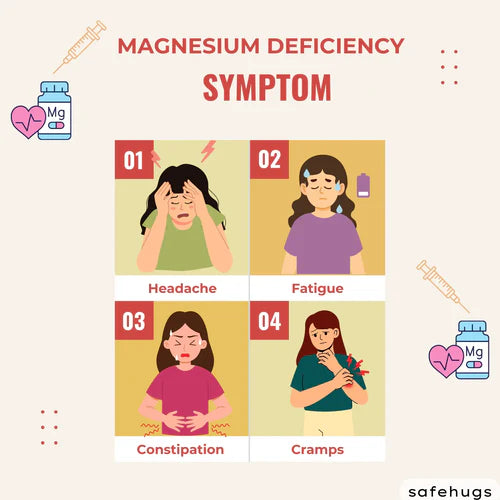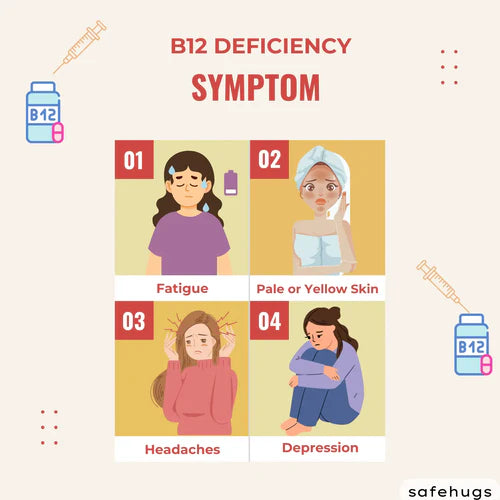Hypocalcemia in Child : What Are the Signs, Symptoms & Supplements

Symptoms of Calcium Deficiency in Kids
Calcium deficiency in kids can cause weak bones, delayed growth, and muscle cramps, along with brittle nails, tooth decay, and a higher risk of fractures. Severe cases may lead to tingling sensations, irritability, or difficulty concentrating. Calcium is crucial for building strong bones and teeth and supporting proper muscle and nerve function. A diet including dairy, leafy greens, and fortified foods can help prevent this deficiency. Here are the key symptoms associated with calcium deficiency in kids.
Low Calcium levels Symptom
- Muscle Cramps and Spasms: Commonly in the hands, feet, or legs, caused by calcium's role in muscle contraction.
- Numbness and Tingling (Paresthesia): Sensations of tingling or numbness, especially around the lips, fingers, and toes.
- Fatigue and Weakness: Persistent tiredness, low energy levels, and general muscle weakness.
- Irritability and Mood Changes: Increased irritability, anxiety, or even depression due to calcium’s impact on nerve signaling.
- Difficulty Concentrating: Trouble focusing or "brain fog" as a result of impaired nerve function.
- Dry Skin and Brittle Nails: Calcium deficiency can cause skin to become dry and nails to weaken or break easily.
- Hair Loss: A lack of calcium may lead to thinning or loss of hair in severe cases.
- Tooth Decay: Calcium is essential for strong teeth, and deficiency can lead to dental problems like cavities.
- Bone Pain and Fragility: Weak or brittle bones may lead to pain, fractures, or osteoporosis over time.
- Tingling Around the Mouth: A classic early symptom linked to low calcium levels affecting nerve health.
- Irregular Heartbeat (Arrhythmias): Disrupted calcium balance can affect the heart's rhythm and overall function.
- Seizures: Severe calcium deficiency can cause seizures due to unstable electrical activity in the brain.
Low Calcium levels Symptom
- Muscle Cramps and Spasms: Commonly in the hands, feet, or legs, caused by calcium's role in muscle contraction.
- Numbness and Tingling (Paresthesia): Sensations of tingling or numbness, especially around the lips, fingers, and toes.
- Fatigue and Weakness: Persistent tiredness, low energy levels, and general muscle weakness.
- Irritability and Mood Changes: Increased irritability, anxiety, or even depression due to calcium’s impact on nerve signaling.
- Difficulty Concentrating: Trouble focusing or "brain fog" as a result of impaired nerve function.
- Dry Skin and Brittle Nails: Calcium deficiency can cause skin to become dry and nails to weaken or break easily.
- Hair Loss: A lack of calcium may lead to thinning or loss of hair in severe cases.
- Tooth Decay: Calcium is essential for strong teeth, and deficiency can lead to dental problems like cavities.
- Bone Pain and Fragility: Weak or brittle bones may lead to pain, fractures, or osteoporosis over time.
- Tingling Around the Mouth: A classic early symptom linked to low calcium levels affecting nerve health.
- Irregular Heartbeat (Arrhythmias): Disrupted calcium balance can affect the heart's rhythm and overall function.
- Seizures: Severe calcium deficiency can cause seizures due to unstable electrical activity in the brain.
What is hypocalcemia?
Hypocalcemia is a condition where blood calcium levels are too low, affecting bones, muscles, nerves, and heart function. It can cause symptoms like muscle cramps, tingling, fatigue, and irregular heart rhythms. Common causes include poor calcium or vitamin D intake, kidney issues, or hormonal imbalances like hypoparathyroidism. Treatment involves calcium supplements, vitamin D, and a diet rich in calcium-containing foods. Early diagnosis is crucial to prevent severe complications and maintain health.
Reason for low hypocalcemia
- Inadequate Dietary Intake: A lack of calcium-rich foods like dairy, leafy greens, and fortified products.
- Vitamin D Deficiency: Low vitamin D levels reduce calcium absorption in the intestines.
- Hypoparathyroidism: Underactive parathyroid glands cause insufficient production of parathyroid hormone, which regulates calcium levels.
- Chronic Kidney Disease: Impaired kidney function prevents calcium reabsorption and increases calcium loss.
- Medications: Certain drugs like diuretics, anticonvulsants, and chemotherapy agents can lower calcium levels.
- Gastrointestinal Disorders: Conditions like Crohn's disease or celiac disease hinder calcium absorption.
What Are the Signs & Symptoms of Hypocalcemia in Babies?

Hypocalcemia, or low calcium levels in the blood, can significantly affect infants and may lead to various symptoms. The severity and type of symptoms depend on how low the calcium levels are and how quickly the drop occurred.
- Irritability and Fussiness: Babies may cry excessively or appear unusually unsettled.
- Twitching or Muscle Spasms: Involuntary movements, especially in the face or extremities.
- Poor Feeding: Difficulty latching or feeding due to weak muscles or fatigue.
- Tingling Sensations: May present as unusual movements or discomfort in the hands, feet, or face.
- Seizures: Severe hypocalcemia can lead to convulsions or jerking movements.
- Lethargy: Low energy levels, sleepiness, or reduced responsiveness.
- Abnormal Heart Rhythms: Irregular heartbeat due to disrupted calcium's role in heart function.
- Delayed Growth: Chronic low calcium can affect bone and overall physical development.
If hypocalcemia is suspected, it’s essential to seek medical evaluation promptly for proper diagnosis and treatment.
What Causes Hypocalcemia in Babies?
- Premature Birth: Underdeveloped parathyroid glands in premature infants can lead to low calcium regulation.
- Vitamin D Deficiency: Insufficient vitamin D in the mother or baby reduces calcium absorption.
- Maternal Diabetes: Babies born to diabetic mothers are at higher risk of hypocalcemia.
- Genetic Disorders: Conditions like DiGeorge syndrome or hypoparathyroidism affect calcium regulation.
How Is Hypocalcemia Diagnosed?
- Medical History and Symptoms: A healthcare provider reviews the patient’s medical history and symptoms, such as muscle cramps, tingling, or fatigue.
- Blood Tests: Tests measure calcium levels in the blood, along with related markers like vitamin D, magnesium, phosphorus, and parathyroid hormone (PTH).
- Urine Tests: These evaluate calcium excretion to determine if the deficiency is caused by excessive loss.
- Underlying Conditions: Diagnostic tests may identify conditions like kidney disease, hypoparathyroidism, or vitamin D deficiency contributing to low calcium levels.
How Is Hypocalcemia Treated?
- Calcium Supplements: Oral or intravenous calcium is administered depending on the severity of the deficiency.
- Vitamin D Therapy: Helps improve calcium absorption in the intestines and restore normal levels.
- Dietary Changes: A diet rich in calcium-containing foods, such as dairy, leafy greens, and fortified products, is recommended.
- Treating Underlying Causes: Addressing conditions like hypoparathyroidism, kidney disorders, or vitamin D deficiency is crucial for long-term management.
- Magnesium Supplementation: If magnesium deficiency is present, it is treated to ensure proper calcium regulation.
Sign of Calcium Deficiency
- Calcium Supplements: Oral or intravenous calcium is administered depending on the severity of the deficiency.
- Vitamin D Therapy: Helps improve calcium absorption in the intestines and restore normal levels.
- Dietary Changes: A diet rich in calcium-containing foods, such as dairy, leafy greens, and fortified products, is recommended.
- Treating Underlying Causes: Addressing conditions like hypoparathyroidism, kidney disorders, or vitamin D deficiency is crucial for long-term management.
- Magnesium Supplementation: If magnesium deficiency is present, it is treated to ensure proper calcium regulation.
Calcium Deficiency in Toddler Teeth
Calcium is essential for the healthy development of a toddler's teeth and bones. A deficiency in calcium can lead to:
- Weak Tooth Enamel: Making teeth more prone to cavities and decay.
- Delayed Tooth Eruption: Slower appearance of baby teeth due to inadequate calcium levels.
- Brittle or Fragile Teeth: Increased likelihood of chipping or cracking.
- Tooth Discoloration: Teeth may appear yellowish or translucent due to weak enamel.
- Increased Risk of Dental Issues: Poor calcium intake may result in long-term dental problems.
To prevent calcium deficiency, ensure toddlers consume calcium-rich foods such as milk, cheese, yogurt, leafy greens, and fortified products. Vitamin D is also essential to enhance calcium absorption.
Symptoms of Calcium Deficiency in Babies
- Irritability and Fussiness: Babies may cry more often and seem unsettled.
- Delayed Tooth Eruption: Teeth may take longer to develop due to insufficient calcium.
- Weak Bones: Increased risk of fractures or poor bone development.
- Muscle Cramps or Twitching: Involuntary movements or spasms due to calcium's role in muscle function.
- Lethargy: Low energy levels and reduced activity.
- Poor Feeding: Difficulty in feeding or reduced appetite.
- Seizures: Severe deficiency may lead to seizures caused by disrupted nerve signaling.
- Slow Growth: Stunted physical growth and delayed milestones.
Sign of Calcium deficiency in Pregnancy
- Muscle Cramps: Commonly in the legs, caused by calcium's role in muscle contraction.
- Fatigue and Weakness: Persistent tiredness and reduced energy levels.
- Bone Pain or Weakness: Increased risk of fractures or discomfort due to calcium being diverted to the baby’s development.
- Dental Problems: Tooth decay, weak teeth, or gum issues.
- Tingling Sensations: Numbness or tingling in the fingers, toes, or face due to disrupted nerve function.
- Brittle Nails and Hair: Weak, brittle nails and thinning hair.
- Irritability or Mood Swings: Calcium’s role in nerve function can affect mood stability.
- Abnormal Heart Rhythms: Severe deficiency may cause irregular heartbeats.
How much calcium do people need?
| Age Group | Recommended Intake (mg/Day) |
| Birth to 6 Months | 200 mg |
| Infant 7 to 12 Months | 260 mg |
| Children 1 to 3 Years | 700 mg |
| Children 4 to 8 Years | 1000 mg |
| Children 9 to 13 Years | 1300 mg |
| Teens 14 to 18 Years | 1300 mg |
How to increase Calcium Intake Naturally
- Dairy Products: Include milk, yogurt, cheese, and other dairy items for a rich source of calcium.
- Leafy Greens: Add spinach, kale, broccoli, and collard greens to your meals for plant-based calcium.
- Fortified Foods: Choose calcium-fortified cereals, plant-based milk (like almond, soy, oat), and orange juice.
- Nuts and Seeds: Snack on almonds, sesame seeds, chia seeds, and sunflower seeds.
- Fish: Consume calcium-rich fish such as salmon, sardines, and mackerel (with bones).
- Legumes and Tofu: Include beans, lentils, and calcium-set tofu for plant-based calcium options.
Calcium Rich Food for Babies
- Breast Milk or Formula: The main source of calcium in the first year of life.
- Full-Fat Dairy: After 1 year, offer whole milk, yogurt, and cheese for calcium.
- Fortified Plant-Based Milk: Soy or almond milk fortified with calcium for lactose-intolerant babies.
- Pureed Leafy Greens: Pureed spinach, kale, and collard greens are good sources of calcium.
- Tofu: Calcium-set tofu can be mashed or blended for easy consumption.
- Fortified Cereals: Calcium-enriched cereals that can be incorporated into baby meals.
Baby Calcium Supplement
- Liquid Calcium Supplements: Often recommended for infants who are not getting enough calcium from their diet.
- Chewable Tablets: For toddlers (typically after 1 year), chewable calcium tablets or gummies can be an easy option.
- Calcium with Vitamin D: Many calcium supplements for babies are combined with vitamin D to enhance absorption.
- Calcium-Fortified Products: Calcium-fortified infant formulas or juices are an alternative for babies not breastfeeding.
- Dosage: It's important to follow a pediatrician’s advice on the proper dosage, as too much calcium can cause issues.
- Natural Alternatives: If possible, aim to increase calcium intake through natural food sources like dairy, leafy greens, and fortified foods.
How can hypocalcemia be prevented?
- Ensure Adequate Calcium Intake: Consume calcium-rich foods like dairy, leafy greens, fortified foods, and fish.
- Get Sufficient Vitamin D: Vitamin D is essential for calcium absorption, so spend time in sunlight and include vitamin D-rich foods like eggs, fatty fish, and fortified products.
- Balanced Diet: Eat a well-rounded diet that includes magnesium and phosphorus to support calcium metabolism.
- Supplements: If necessary, take calcium and vitamin D supplements, especially for individuals at higher risk, such as pregnant women, infants, or elderly people.
- Monitor Medical Conditions: Manage conditions like kidney disease, parathyroid disorders, or hormonal imbalances that can affect calcium levels.
- Regular Check-Ups: Routine blood tests and medical check-ups help detect low calcium levels early and prevent complications.
When to Call for Help
- Severe Muscle Cramps or Spasms: If your child experiences painful or persistent muscle cramps or spasms.
- Tingling or Numbness: If your child complains of tingling sensations or numbness in the hands, feet, or face.
- Unexplained Fatigue or Weakness: If your child is unusually tired, weak, or lethargic, and it doesn’t improve with rest.
- Difficulty Breathing or Chest Pain: Any signs of difficulty breathing, chest pain, or irregular heartbeat, as calcium deficiency can affect the heart.
- Seizures: If your child has a seizure or convulsions, which could be a sign of severe calcium deficiency.
- Poor Growth or Delayed Development: If you notice significant delays in growth or developmental milestones, consult a healthcare provider.
If you notice any of these signs or suspect your child may have calcium deficiency, seek medical attention promptly to address the issue.
Discover Safehugs clothes that care for your little one’s comfort—soft, stylish, and gentle on the skin, offering a safe embrace.
Related:
FAQ'S
1. What are calcium deficiency symptoms on skin ?
Calcium deficiency can cause dry, rough skin, rashes, and brittle nails. It may also lead to delayed wound healing and a pale complexion.
2. How do you know if your child is lacking in calcium?
If your child is experiencing muscle cramps, weakness, or frequent bone pain, they may be lacking in calcium. Other signs include poor growth, delayed tooth development, and brittle nails.
3. How can I increase my child's calcium?
You can increase your child's calcium by including dairy products, leafy greens, and calcium-fortified foods in their diet. Offering calcium-rich snacks like cheese, yogurt, and almonds can also help.
4. What are two signs of low calcium?
Two signs of low calcium are muscle cramps and tingling sensations in the fingers or toes. These symptoms occur due to calcium's role in muscle function and nerve signaling.
5. How to check calcium levels in children?
Calcium levels in children can be checked through a blood test, which measures the total calcium and ionized calcium levels. A healthcare provider may recommend this test if calcium deficiency is suspected.



























